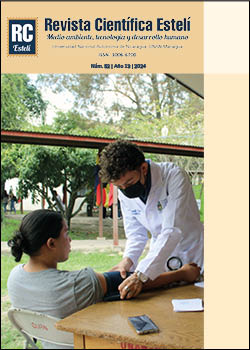Analysis of flooding in basin number 9529319-6 (Río Seco) of the pacific of Nicaragua, using the HEC-RAS model
DOI:
https://doi.org/10.5377/esteli.v13i52.19985Keywords:
Territorial planning, HEC-RAS, flood analysis, vulnerability to floodingAbstract
Nicaragua’s vulnerability to disasters was exposed with the passage of Hurricane Mitch in October 1998, which led the Nicaraguan State to establish in March 2000 a comprehensive system for Disaster Risk Reduction (DRR) called the “National System for Disaster Prevention, Mitigation and Response (SINAPRED) (IFRC, Disaster Risk Reduction). 2013, p. 5). The municipality of Nagarote is exposed to both natural and man-made threats; mainly associated with hydrometeorological phenomena. In a risk level classification carried out in 151 municipalities in Nicaragua, Nagarote ranks 14th, where position 1 represents the highest risk. The main threats in the area are drought, rated at the highest level, followed by the risk of floods and seismic activity (ENACAL, 2019, p.60). In addition, the lack of detailed mapping prevents the precise identification of the affected areas and the extent of the surface water surface. Against this background, this study carries out an analysis of flooding in the basin, with the aim of spatially identifying the most vulnerable areas and the level of the surface water surface. To this end, hydrological modelling was used using geographic information systems and the HEC-GeoRAS tool, simulating scenarios for return periods of 10 and 25 years. The main results indicate that the areas with the highest exposure to flooding correspond to the most populated areas of the municipality. Similarly, most of the dry river is unable to channel the waters, which causes flooding on both banks of the river where water velocities range from 01 to 39 m/s, while the surface water varies between 1 and 3 meters in height in some areas of the watershed. That is why the identification of flood zones in the event of an extreme event is of great importance in territorial planning and risk management, especially in highly exposed municipalities in Nicaragua.
Downloads
References
Alcanta Boza , A., & Castro Tenorio , A. (2021). Determinacion de las zonas inundables con HEC-RAS en zonas de la cordillera Central de los Andes. Micorucneca del rìo Saraus-rio La llanga. Celedin. Revista del Instituto de investigación de la Facultad de minas, metalurgia y ciencias geográficas , 24(48), 181-187. https://doi.org/1561-0888
Alcántara , A., & Castro, A. (2021). nst. investig. Fac. minas metal. cienc. geogr., 186. https://doi.org/https://doi.org/10.15381/iigeo.v24i48.19852
Alcantara, A. (2019). Inlfuencia de la Geomorfologia y la Meteorizacion en la humedad del suelo y la recarga de agua en la cabecera del rìo Jequetepeque. 22(43), 101. https://catalogobiblioteca.ingemmet.gob.pe/cgi-bin/koha/opac-detail.pl?biblionumber=48685
Cabrera , C., & González , R. (2017). Estrudio para determinar el Coeficiente C de Escorrentía en la Zona Norte del Río Tomebamba. Universidad de Azuay.
Cordero , Z. (2009). La investigacion aplicada: una forma de conocer las realidades con evidencia cientifica. 159. https://www.redalyc.org/pdf/440/44015082010.pdf
ENACAL. (2019). Estudio de factibilidad del sistema de alcantarillado sanitario ciudad de nagarote. Retrieved 2024, from https://www.bcie.org/fileadmin/bcie/projects/500831/6_ANALISIS_AMBIENTAL_NAGAROTE.PDF.pdf
Fenoglio, P. (2019). Inundaciones urbanas y cambio climático : recomendaciones para la gestión. Secretaría de Ambiente y Desarrollo Sustentable de la Nación. https://www.argentina.gob.ar/sites/default/files/manualinundaciones.pdf
FICR. (2013). Nicaragua Estudio de Caso. Cómo la Ley y la Normativa Apoyan la Reducción de Riesgo de Desastre. Retrieved 15 de Enero de 2024, from https://www.preventionweb.net/files/globalplatform/entry_bg_paper~ifrcdlpnicaraguarrdestudiocasoesp2013.pdf
INETER. (2005). Geofísica. ineter. Retrieved 2024, from Geofísica en Nicaragua: https://web-geofisica.ineter.gob.ni/proyectos/30municipios/nagarote/mapas/Nagarote_Amenaza%20por%20Deslizamientos%20e%20Inundaciones_Escala%2050%20mil.pdf
INIDE. (2005). Nagarote en Cifras. Instituto Nacional de Información de Desarrollo (INIDE) : https://www.inide.gob.ni/docu/censos2005/CifrasMun/LeonTPDF/Nagarote.pdf
Manrique , A., Nájera, A., Escartín, C., Moreno, C., Martínez, E., Espejo, F., . . . González, S. (2017). Guía para la reducción de vulnerabilidades de los edifiuciones frente a inundaciones. Consorcio de Compensación de Seguros. https://ebroresilience.com/wp-content/uploads/2018/12/guia_inundaciones_completa_22jun.pdf
Marcus, R., Del valle , M., Elizalde , E., Marcor, J., & Cristina, I. (2019). Curvas de Intensidad-Duracion-Frecuencia (IDF) de las estacion meteorológica del CIM-FICH. SERIE 1986-2016. CUADERNOS DEL CURIHAM, 48. https://dialnet.unirioja.es/descarga/articulo/7260055.pdf
Mora, W., & Ochoa , R. (2016). Modelamiento de zonas de inundación por medio de las herramientas hec-ras, geo-ras y arcgis, para el sector comprendido entre los municipios de corrales- paz de rio a lo largo del rio chicamocha, en el departamento de boyacá. Escuela de ingeniería geologica. https://repositorio.uptc.edu.co/bitstream/001/1677/1/TGT-368.pdf
Olcina, J. (2004). Riesgo de inundaciones y ordenacion del territorio en la escala local. El papel del planeamiento urbano municipal. 50. https://dialnet.unirioja.es/servlet/articulo?codigo=930085
Orellana, R. (2021). Modelamiento hidrológico e hidráulico para el análisis de inundaciones en la ciudad de Piura Utilizando HEC-HMS y HEC-RAS. Pontificia Universidad Cattolica del Perú, 87. https://tesis.pucp.edu.pe/repositorio/bitstream/handle/20.500.12404/18304/ORELLANA_CABELLO_RODRIGO_MODELAMIENTO_HIDROLOGICO_HIDRAULICO.pdf?sequence=1&isAllowed=y
Perez, J. (2017). Delimitacion de areas de inundación usando la herramienta HEC-RAS y su aplicativo S.I.G HEC-GEORAS en la Acequia las Mercedes, Valledupar. https://ridum.umanizales.edu.co/xmlui/handle/20.500.12746/4165
Pesaresi , M., Ehrlich, D., Kemper , T., Siragusa, A., Florczyk, A., Freire, S., & Corbance , C. (2017). Atlas of the Human Planet 2017. JRC Science Hub. https://doi.org/10.2760/19837
SINAPRED. (2005). Plan de Gestion de riesgo Nagarote. SINAPRED. https://web-geofisica.ineter.gob.ni/proyectos/30municipios/nagarote/informes/NiR%20D%20POT%20Nagarote%2020051121.pdf
SINAPRED. (2005). Plan de Ordenamiento Territorial Municipal en Funcion de las Amenzas Naturales. Retrieved 15 de 01 de 2024, from https://165.98.224.55/geofisica/proyectos/30municipios/nagarote/informes/NiR%20D%20POT%20Nagarote%2020051121.pdf
SINAPRED. (2005). Reporte sobre las Amenazas, Vulnerabilidad y Riesgos ante Inundaciones, Deslizamientos, Actividad Volcanica y Sismos. INETER. https://web-geofisica.ineter.gob.ni/proyectos/30municipios/nagarote/informes/NiR%20D%20RA%20Nagarote%2020051118%20MG.pdf
Tirado , V. (2023). Comparación de la curva Repetición, Magnitud y Persistencia de una estación hidrometeorológica con la base de datos climáticos globales de WorldClim. iYA, 42. https://portalderevistas.uam.edu.ni/index.php/iyA/article/download/102/90/182
Tirado , V., & Blandón, L. (2023). Methodology for the Calculation of the Runoff Coefficient with the Arrangement Tirado. Scientific Research Publishing Inc, 659-671. https://doi.org/10.4236/ojapps.2023.135052.
Downloads
Published
Issue
Section
License
Copyright (c) 2025 Revista Científica Estelí

This work is licensed under a Creative Commons Attribution-NonCommercial-ShareAlike 4.0 International License.

